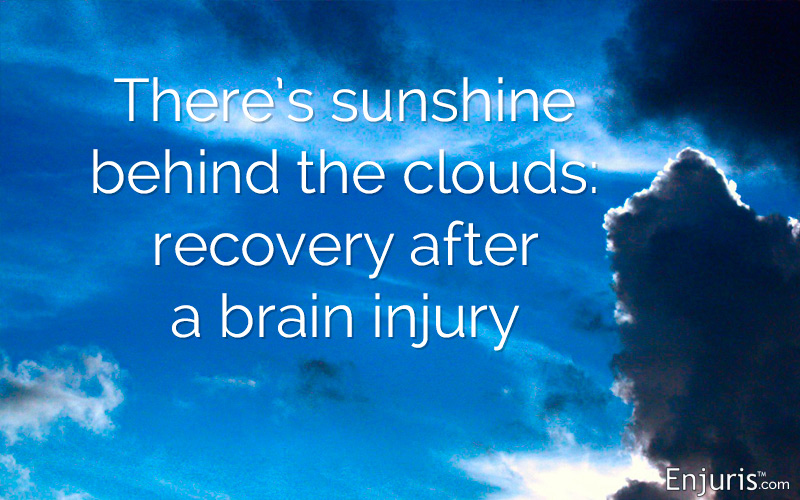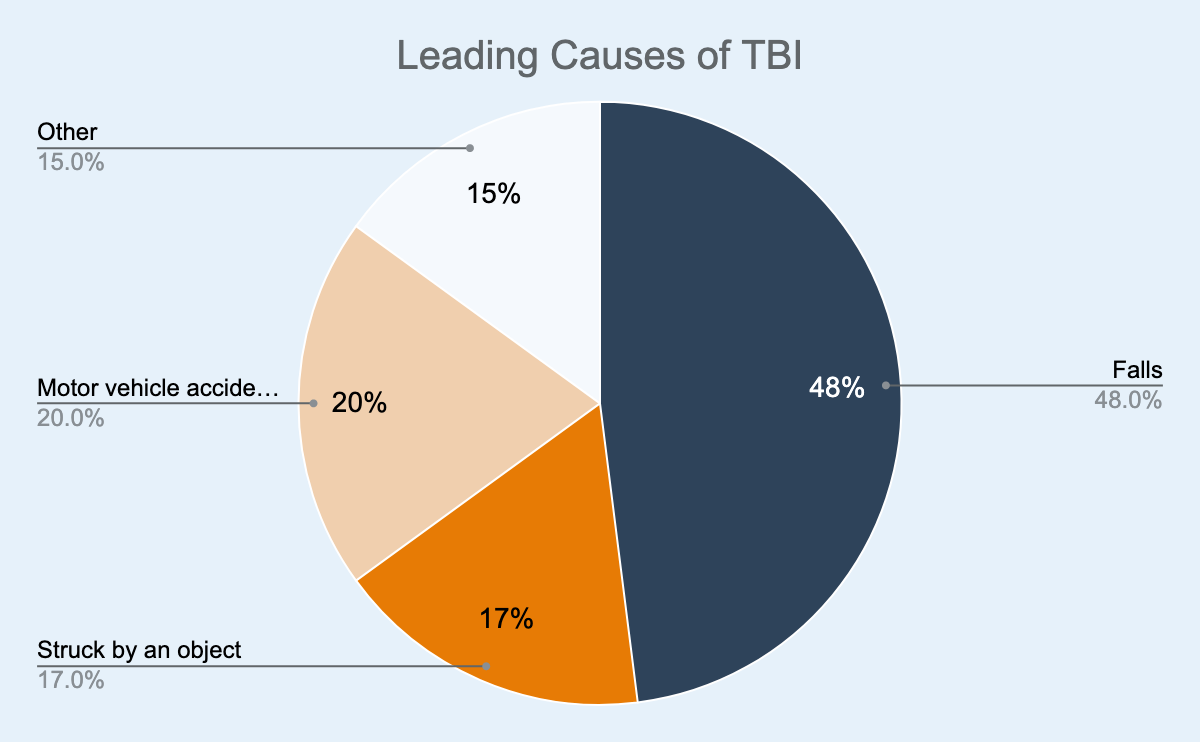A personal injury lawsuit can be your lifeline to covering costs for a lifetime of care
Ouch!
We've all gotten a good head-bump here and there. Maybe you've even seen stars, like in the cartoons. Or perhaps you got a bump that swelled up like a giant egg. It happens.
But even though those cartoon characters can be beaten flat with a frying pan to the head, or dumped on their skulls from a 15-story building and pop right back up, unfortunately it doesn't work like that in real life.
What is TBI?
A traumatic brain injury (TBI) is a bump, blow, or jolt to the head that disrupts the normal function of the brain. Of course, some head bumps are mild and leave you with a bruise that heals in a few days. Even if a bump is a TBI, it could be mild and resolve in a short time—most people know that injury as a concussion.
Here are the most recent statistics on TBI from 2014, according to the Centers for Disease Control and Prevention (CDC):
| Type of TBI-Related Injury | # of People |
|---|---|
| TBI-related emergency room visits, hospitalizations and deaths | 2.87 million |
| Deaths from TBIs | 56,800 |
| Deaths from TBIs in children | 2,529 |
| TBI diagnoses in hospitalizations | 288,000 |
| TBI diagnoses in hospitalizations of children | 23,000 |
| Children treated in U.S. ERs for concussion or TBI | 812,000 |
| Source: CDC | |
Common causes of TBI
Here's a look at what causes TBI:
Traumatic brain injuries and head trauma can be caused by:
- Slip and falls
- Assault (child abuse, domestic violence, shaken baby syndrome)
- Car crashes
- Workplace injuries
- Sports injuries
- Military action (blast injury)
- Gunshot wounds
Your brain can also be injured in ways that are not related to a traumatic event or hit to the head. These causes include:
- Stroke
- Infectious disease (meningitis, encephalitis)
- Drug overdose
- Lack of oxygen (drowning, choking, hypoxia)
- Carbon monoxide or lead exposure
- Metabolic disorders
- Exposure to toxins
- Tumor
- Electric shock
- Seizure
Age and risk factors for TBI
Are you at risk for TBI? People age 75 years old or older are at the highest risk, and the leading cause is falls. For individuals between 45-64 years old, the leading cause of death from a TBI was intentional self-harm. In children under 5 years old, homicide is the leading cause of TBI-associated death.
Understanding different types of traumatic brain injuries
We've now seen a laundry list of what causes TBI and who's at the highest risk. We talked about bumps and jolts.
But what, exactly, is a TBI, and what does that mean? Here's some examples about the effects of TBI on the brain:
- Diffuse axonal injury. Shaking or strong rotation of the head, most likely in a car accident, can critically injure the brain's functions.
- Concussion. A concussion can happen any number of ways, including violent shaking or whiplash. It's the most common kind of brain injury, though it's classified as a mild brain injury (mTBI).
- Contusion. Bleeding in the brain caused by force or trauma to the head can impair basic bodily functions.
- Coup-contrecoup injury. This is an injury that happens when there's impact on one side of the brain, but also the opposite side, which is the result of impact forceful enough to move the brain and slam it into the opposite side of the skull.
- Second-impact syndrome. If someone has suffered a TBI and then experiences a second event before the first has healed, the second impact is more likely to cause brain swelling and widespread damage.
- Penetrating injury. Penetration from a bullet, knife, or any object can force hair, skin, and fragments into the brain can result in catastrophic and long-term harm.
- Abusive head trauma. Characterized as “Shaken Baby Syndrome”, this type of TBI happens when an abuser shakes a baby or small child in a violent and aggressive way, which causes whiplash.
- Locked-in syndrome. This is a very rare condition. An affected person cannot move any part of the body other than their eyes.
- Open head injury. This is another form of a penetrating injury, in which the outer layer of the brain is broken and exposed. This type of TBI happens because of impact from a projectile driven into the brain.
- Closed head injury. In this injury, the brain is damaged without the skull being penetrated. It means that the brain could swell and be unable to expand through the skull, which often results in pressure inside the skull.
Symptoms of TBI and serious head injuries
The Montana Brain Injury Alliance offers a list of symptoms and changes that might happen with a brain injury:
| Cognitive | Physical | Emotional |
|---|---|---|
| Short- or long-term memory loss | Seizures | Depression, grief, chemical changes |
| Slowed information processing | Fatigue or insomnia | Anxiety, agitation, frustration, impatience |
| Impaired judgment | Sensory loss or impairment | Lower stress tolerance |
| Language or speech difficulties | Ringing in the ears | Mood swings |
| Spatial disorientation | Issues with muscle control and balance | Impulsivity, lack of inhibition |
| Trouble concentrating | Decreased motor ability | Emotional passivity or flatness |
| Inability to multitask | Sexual dysfunction | |
| Difficulty with problem-solving | Blurred vision | |
| Headaches or migraines | ||
| Dizziness, trouble balancing |
Caring for someone with a TBI
Your loved one's medical providers will give you a list of specifics based on the nature and severity of the injury. Most importantly, they'll need lots of rest and to be protected from a second impact to the head.
But what if you're in a position to advocate for their legal and financial needs, too?
Unfortunately, the hospital won't send you home with a list of instructions for that.
If your loved one was in an accident that resulted in a TBI, you might want to begin exploring legal options.
Here's one example of a Montana lawsuit involving a TBI:
| Case study: 16-year-old Montana high school football player suffers TBI |
|---|
| Facts: Robert Back was a 16-year-old Great Falls high school football player who suffered a concussion during a game. He saw two doctors in the week following the injury, and the doctors told him not to return to football until he was cleared. Back's parents claim that the athletic officials at Robert's school put him back in the game a week later.
That night, Back collapsed on the sidelines. A surgeon at Benefis Hospital in Great Falls later removed a large portion of his skull in order to relieve the pressure from his brain. However, the damage was done and 16-year-old Robert now lives as a quadriplegic. |
| Analysis: The main question in this lawsuit was who gave Robert permission to return to football and whether his parents knew that he was playing without the doctor's clearance. Those are legal issues of fact that will remain at the forefront of the case as litigation continues.
Robert's attorneys sought $20 million in damages. They claimed that if Back lives to be 57 years old, his medical expenses will equal more than $22 million dollars. |
| Result: A Montana jury found that the hospital wasn't liable for Robert's injuries. Robert's parents reached a settlement with the Great Falls high school in the amount of $750,000, but they didn't recover damages from the lawsuit defendants.
However, if the jury had determined that the defendants were liable, damages would still hinge on the plaintiffs' (Robert and his father) liability for his having played in the game. |
Montana is a modified comparative fault state, and this can affect your head or brain injury case.
For example, in Robert Back's lawsuit described above, if Robert and his father (also a plaintiff) were found to be liable in any way for his injury, their damage award would be reduced. So, if they were found to be 30 percent liable, they'd only be eligible to receive 70% of the total damages. Since Montana is a modified comparative fault state, if they were 51% liable or more, they wouldn't receive any damages in the lawsuit.
Fault Systems by State
View Full Size Get the Code Use this graphic on your site
Use this infographic on your site
We encourage people to use our infographics, with proper attribution. Just copy and paste the code below to use this infographic on your site. If you need help, let us know!
<a href="https://www.enjuris.com/personal-injury-law/shared-fault-rules/" target="blank"><img src="https://www.enjuris.com/wp-content/uploads/2022/10/fault-systems-by-state-2022.gif" alt="Fault Systems by State" title="Fault Systems by State" style="width: 100%; max-width: 987px; display: block; margin: 15px auto;" /></a>
Head and brain injuries at work
If the TBI happened at work, Montana workers' compensation insurance should cover the expenses associated with a catastrophic injury.
A workers' compensation settlement can cover expenses associated with:
- Medical treatment (both immediate emergency treatments and ongoing doctor and hospital visits)
- Surgery
- Prescription medication
- Lost wages (both past and future)
- Assistive devices (like a wheelchair or modifications to the home)
- Caregiver costs
- Ongoing therapies
- Diagnostic testing
Negligence and TBI
If the injury is not job-related, you might need to sue the negligent party. Your damages can be assessed for each of the above costs, and in a civil lawsuit you can also recover damages for pain and suffering.
Your lawyer will help you navigate the legal system. They'll advise you on the best course of action in your situation. You can start by asking your lawyer the following questions:
- What would be a fair settlement in my case?
- What are my case's strengths? Weaknesses?
- How likely is it that my case can settle out of court?
- How long do you think the litigation process will take for this kind of case?
- Are there cases like mine in the news or elsewhere that I can look at to learn about my chances of winning?
- Are there recent cases that might affect the outcome of my case?

Worksheet with questions to ask a personal injury attorney to help determine if he or she will be a good fit for your case
Download in PDF format
For additional help, here's a list of TBI and head injury resources in Montana and nationwide:
- Montana Brain Injury Center
- Brain Injury Alliance of Montana
- Montana Department of Public Health and Human Services
- Marcus Daly Memorial Hospital
- Billings Clinic
- United States Brain Injury Association
- Brain Injury Association of America
- Brain Trauma Foundation
- National Rehabilitation Information Center
See our guide Choosing a personal injury attorney.




